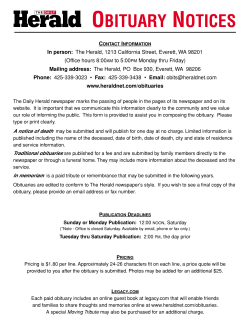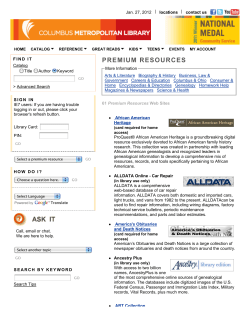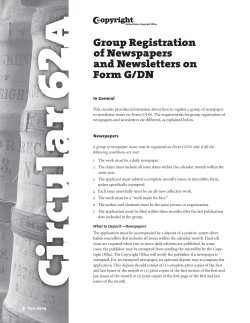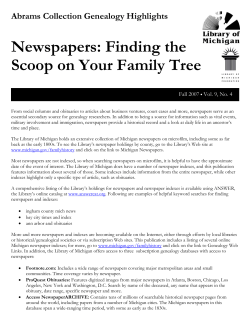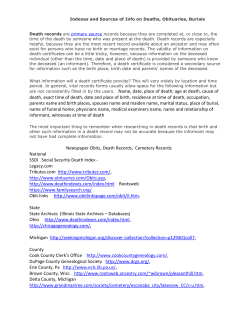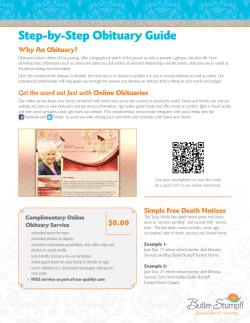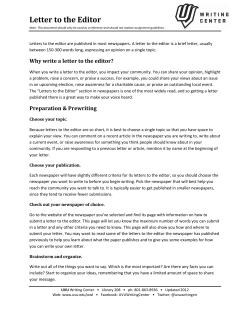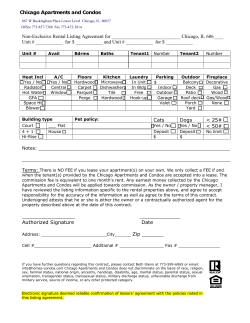
Read All About It: Using Newspapers That Was Then: This Is Now:
1 Read All About It: Using Newspapers Linda Herrick Swisher LHSwish@comcast.net That Was Then: This Is Now: Equipment Presses were transported by trains/wagons. Papers are laid out on computer & sent electroni‐ Type was set by hand. Newsprint was often scarce or expensive. Some papers were printed on cloth. cally to high‐speed presses. Paper may be in print/ online. Newsprint is still expensive; many papers cut their size, or folded due to technology. Editors Some editors/employees had little formal education (misspellings, grammar errors). Help was scarce as men went to Civil War. Most editors/reporters have college education. Misspellings still occur (overreliance on spell‐ check?) and the trend to “text” in shorthand. Content Columns of text, or serialized stories (Ansel Nash Kellogg’s “patent insides”); few photos/ illustrations. Not politically correct; bias was common. Yellow journalism. Often more than one edition a day. “News bites”; many photos, graphs, illustrations. More politically correct, though still some bias. Less sensationalism. Often just 1 edition/day, since online news is updated often & cheaper. Format Papers may have been a single sheet. News and ads ran anywhere. Ansel Nash Kellogg, “father of the newspaper syndicate” printed national stories and serials on 1 side of a sheet, then shipped to towns, where local editors printed news on the blank side. News may be both online/in print, or online only. Print papers are usually divided into sec‐ tions, so news is easier to locate. Syndicates still provide stories, comics and columns to the local paper. Funding Editors sought ads and subscribers. Since people shared the paper with others, it was read by many more than just subscribers. Some editors accepted goods or produce as payment for ads, in lieu of cash. While every paper needs readers, ad revenue pays the bills. Papers are charging to access news online. Publishers own papers in several states. Caveats: • • • • • • Put ancestors into historical context. Consider the attitudes and mores of the time. Expect gory, grisly news stories as well as lighter social “fluff.” Look for stories about records, landmarks or places that no longer exist. Older papers had less objectivity. You may find name‐calling, character assassination, racism/ prejudice, partisanship, no distinction between news/ads or between fact/opinion. Expect missing issues, small print, misspellings, haphazard layout, or questionable content. When using online papers: Optical Character Recognition + small/smudged newsprint = gibberish. Searches may include words proximate to each other. A search for John Smith may pull up false hits such as John Doe at Smith Brothers Store. Using quotes around search terms may help, but may also eliminate family who appear as John Calhoun Smith, or John and Mary Smith. What you may find: I. VITAL STATISTICS • Death: Obituary; death notice; necrology; list of dead; death anniversary; notice of death/thanks/ probate; social items (illness/injury/relatives arriving in anticipation of death); fraternal notice (union/social organization); disposition; remembrance ad (Mothers Day, Memorial Day); coroner inquest (suspicious death); memorial service (possibly cremated/buried elsewhere); “arrangements incomplete”(check future issues for more info). Info may differ between papers/different issues of the same paper. Families may have preferred one paper over another; obits may not appear in both. Not all had an obit, or some papers may have a smaller obit, especially if there was a charge and the family could not afford it. Some papers ran both obits and death notices. 2 • • • Marriage: Family, guests, attendants, attire, decorations, gifts; photo; occupations; residence. Wedding may have been on a weekday. Issuance of a license is no guarantee of a wedding! Milestones (Anniversary, birthday, multigeneration photo) marriage date/place, children, etc. Birth (Early:) Possibly mentioned only in society news, as a notice of baptism, or if died young. Notice may say “infant” but no gender, or “son” but no name. Baptism does not always indicate an infant, as siblings may have been baptized together. Notice of birth does not mean a child was born there. Women may have returned to the home of parents or sisters to give birth. (Today, if found at all:) Usually provided by parents; or by hospitals with parental permission. Circa 1900s‐1970s: may list mother as “Mrs. John Jones” without her first name. Circa 1990s‐present: Births may not be submitted for privacy, or if the parents are unmarried. Check classifieds for “happy ads” (“Happy 40th Birthday”, etc.) You may find only the gender. The infant’s name may be withheld for privacy, or to standardize information submitted by hospitals. II. ESSENCE OF COMMUNITY • News: disasters, drought, accidents • Social items: schools, churches, entertainment, organizations, reunions. More women and children are mentioned here in their own right • National and local news/national news with local slant: fires, floods, natural disasters, • Histories/biographies: Prominent people, local history, milestones, year‐end chronology or necrology; after the fact (“50 years ago today”); multi‐generational • Advertisements: local businesses; products and costs • Sociological information: crime statistics; political appointees and viewpoints. III. LEGAL NOTICES/CLASSIFIEDS • Land/sheriff sales: Title changes; property transfers; land records. • Tax lists: residency; property owners. • Jurors, road commission: residency; neighbors. • Government accounts: town; school districts; governmental bodies (poor farm, coroner) • Divorce: court papers; guardianship • Probate: narrow death date; establish family relationship. • Children’s issues: guardianship; name changes; adoption. • Runaway notices: servant, slave, spouse. (Don’t assume infidelity! — maybe domestic violence?) IV. IMMIGRATION/MIGRATION/MOVES • Ship or train arrivals, passengers; relocating settlers; naturalization ceremonies • Hotel guests for business, or visiting relatives • Unclaimed letters at the post office show current or former residency. • Moves, relocations, employment information • Missing persons, perhaps emigrated from old country and not heard from again. • Orphan trains/baby trains: lists of children; adopting families. V. ETHNIC PRESS • Greater opportunity for recognition • Bigger paper is not always better • If foreign language, learn key words (born, died, married) and surname variants (grammar/gender) VI. RELIGIOUS PRESS • Greater opportunity for recognition • Members • News and history of denomination, congregation or clergy • Possibly foreign language (i.e., German or Swedish Lutherans, Italian or Polish Catholics) 3 VII. SPECIALIZED PRESS • Community papers (helpful in large urban areas) • Trade/union/company newspapers that mention employees • Fraternal/organizational papers that mention members • Hobby/sport/lifestyle (seniors) VIII. USING NEWSPAPERS • Familiarize yourself: dates published; dates extant; frequency; format. • Check research aids: Index, abstract, card file, database. Note limitations. An obituary index may list the deceased, but not survivors. • Ignore jurisdictional boundaries (state/county lines) or time periods (afterthefact). • Note printed clues: “special”, “please copy.” If clipping contains no date or place, check other side, or check for an locality or an event that may be traceable. • Use a bullseye approach, radiating outward from the locality. • Be aware of bias: If editor disliked/disagreed with your ancestor, or had racial, ethnic or reli‐ gious bias, your ancestor’s news may not run, or if it did, it may be unflattering. • Check for other editions (other towns; AM and PM in same town; weekly). The same news may not appear in all editions. Later editions may give more details, or correct errors. • Contact the current paper for assistance: — Place a classified ad, asking for information. — Write a letter to the editor, asking descendants of your ancestors to contact you. — Check for a family history column and place a query. — Check locality for GenWeb sites, genealogical/historical societies, public/academic libraries, etc. IX. LOCATING AND USING NEWSPAPERS How‐to guides: Bobbie’s Genealogy Classroom ‐Your Guide to Using Newspapers for Genealogical Research http://www.barbsnow.net/Newspapers.htm Cooke, Lisa Louise. Everything You Need to Know About How to Find Your Family History in Newspapers. 2012. (ISBN: 5800077595424. Good checklists, online sources) Cyndi’s List http://www.cyndislist.com (Check Newspapers and Obituaries categories for how to find/use papers; genealogy columnists; etc.) FamilySearch Learning Center: Newspapers and Periodicals https://www.familysearch.org/learningcenter/results.html?q=*&fq=subjects%3A%22Newspapers% 20and%20periodicals%2F%22 Genealogy Center (Allen County Public Library) Using Newspapers for Genealogical Research http://www.genealogycenter.org/Pathfinders/Guides/newspaper.aspx http://www.ancestry.com/wiki/index.php?title=Overview_of_Newspapers_in_Family_History Hansen, James L. “Newspapers.” The Source, Rev. ed., Chapter 12. Salt Lake City: Ancestry Publishing Co., 1997. Wollmershauser, Friedrich R., “Using German Newspapers 17801914 for Emigration Research.” http://www.progenealogists.com/germany/articles/gnews.htm Newspaper sites: In addition to the sites below, check the state/county GenWeb site; also public, university or special libraries/ archives/museums; genealogical/historical societies; newspaper office “morgues”; state or national repositories. AccessibleArchives.com ($) Mostly colonial & early US papers including The Pennsylvania Gazette, The Virginia Gazette, some from South Carolina; some from the women’s movement; some African American. Ancestry.com ($) Check these collections for available titles: Historical Newspapers, Birth, Marriage and Death Announcements, 1851‐2003 Newspapers & Publications > Newspapers > (filter by location, dates, or languages) Elephind.com (free?) new database helpful for searching papers. Among the collections is LOC Chronicling America, University of Illinois Collection, others to be added. 4 GenealogyBank.com ($) A release of NewsBank.com. Go to home page to search available titles in Historical Newspapers, 16902007; Newspaper Obituaries 1977current Genealogy Center (Access to several online databases available within the Allen County Public Library) Newspapers on Microfilm http://www.genealogycenter.org/Pathfinders/NewspaperMicrofilm.aspx Google News http://news.google.com/newspapers Legacy.com (free search, $ for results) Library of Congress General sources such as Rowell’s American Newspaper Directory; Ayer’s American News paper Annual; Newspapers in Microform are now online at http://www.loc.gov/rr/news/ammemser.html) National Digital Newspaper Program http://www.loc.gov/ndnp/ Chronicling America: Historic American Newspapers http://chroniclingamerica.loc.gov/ Newspaper and Current Periodicals Reading Room http://www.loc.gov/rr/news/oltitles.html United States Newspaper Program http://www.loc.gov/rr/news/usnp/usnpp.html National Obituary Archive http://www.arrangeonline.com Newberry Library (Access to the Chicago Tribune Database, 18491985; Harpers Weekly 18571912; New York Times 18512003; plus several print indexes is available within the Newberry Library) (Research Guide) The Newberry Library Newspaper Collection http://www.newberry.org/newspapers Newspapers & Periodicals—Reference Sources http://www.newberry.org/newspapers‐periodicals‐reference‐sources NewsBank.com (check local library for free access to papers in your area) Offers these databases: America’s GenealogyBank; America’s Obituaries and Death Notices; Chicago Tribune Historical Archive; Dallas Morning News Historical Archive NewspaperArchive.com ($) (Browse by date, title, locality.) Newspapers.com ($) (Ancestry.comowned. Some overlap with papers currently available on Ancestry.com, although this site is expected to increase its original content.) NewspaperCat Catalog of Digital Historic Newspapers http://newspapercat.org/advanced Obituary Daily Times http://www.rootsweb.ancestry.com/~obituary/ (free; lists date of obits) Online Historical Newspapers (created by Miriam Robbins. Search by state) http://sites.google.com/site/onlinenewspapersite/Home ProQuest Historical Newspapers ($) ‐ check local library Stanford University ‐ Data Visualization: Journalism’s Voyage West Interactive map: The Growth of Newspapers Across the U.S.: 1690‐2011 http://www.stanford.edu/group/ruralwest/cgi‐bin/drupal/visualizations/us_newspapers The Ancestor Hunt: United States Online Historical Newspaper Links (by Kenneth R. Marks. Search by state) http://www.theancestorhunt.com/1/post/2014/04/united‐states‐online‐historical‐newspaper‐ links.html#.U2ryo6IVedy For Illinois (This is by no means complete; it is a snapshot of what is available): (Aurora) Beacon Obituary Index (work in progress; incomplete) http://www.aurora.lib.il.us/genealogy/beacon.obit.php Barrington CourierReview Indexes, 18902006 http://www.barringtonarealibrary.org/local‐history/388‐bcr_indexes (Batavia) Gustafson Research Center: Index of Obituaries, in Binders, Approx. 18612012 http://www.bataviahistory.org/media/1062192/obituary%20master%20index%20‐%20final.pdf Chicago Defender (at ProQuest Historical Newspapers; check local libraries for access. Chicago Public Library has) 5 Chicago Public Library (Access to newspaper databases requires valid Chicago Public Library card) Chicago Newspapers http://www.chipublib.org/cplbooksmovies/cplarchive/newspapers/newspapers.php Chicago Tribune Historical Archives (at ProQuest; check local libraries for access. Chicago Public Library has this) Denni Hlasatel Obituary Index (2 books or 1 CD covers 18911995, published by the Czech & Slovak American Genealogy Society of Illinois, www.csagi.org. Contact the society, or check with local libraries.) Dziennik Chicagoski (Chicago Polish Daily News) Death Notices 18901929 http://www.pgsa.org/dzien9029.php Death notices 19301971 http://www.pgsa.org/dzien3071.php Dziennik Zwiazkowy (Polish Daily Zgoda first 10 years, 19081917) http://ecollections.crl.edu/cdm4/index_dz.php?CISOROOT=/dz Encyclopedia of Chicago Timeline of selected Chicago daily newspapers http://encyclopedia.chicagohistory.org/pages/2474.html Timeline of selected Chicago daily newspapers, foreign language http://encyclopedia.chicagohistory.org/pages/11525.html Highland Park Obituary Index Covers 18742009 for Highland Park Herald, Mail Advertiser, News, Newsletter, Press, Sheridan Road News letter, and North Shore Newsletter. http://hplibrary.org/obituary‐index Hyde Park Herald Archive, 18822010 (some missing) http://hpherald.com/new‐and‐improved‐digital‐archives/ Illinois Digital Newspaper Collection http://www.library.illinois.edu/dnc/ Illinois Newspaper Project ‐ part of U.S. Newspaper Program & National Digital Newspaper Program http://www.library.illinois.edu/inp/ NewsBank (incl. Chicago Tribune Historical Archives?) (check local library for access) Obituaries Published in Mundelein Newspapers (1998?) http://fremontlibrary.org/?q=research‐training/genealogy‐local‐history/local‐history/vital‐records/ obituaries Villa Park Argus Obituary Index (1931‐date. Gaps exist due to missing issues.) http://www.vppl.info/?page_id=1034 Waukegan Public Library Cemetery and Obituary Records http://www.waukeganpl.org/cemetery‐records NON‐NEWSPAPER SITES THAT CAN HELP IN FINDING OBITUARIES: • BillonGraves.com • Find A Grave http://www.findagrave.com Two major online sites where people post photos of cemeteries and gravestones. Finding the place of burial and the gravestone can lead to the newspaper location and narrow the date range for an obituary. • DeathIndexes.com Joe Beine tries to list all available online death indexes for each state, thereunder by county. Large metropolitan areas have their own groupings within the state list. The site indicates whether a search is free, or if a subscription is needed. • Social Security Death Index (Several providers: Ancestry.com; Ancestry Library Edition; FamilySearch.org; other sites) An index to basic information about persons with Social Security numbers whose deaths have been reported to the Social Security Administration. About 98% percent of those in the SSDI died after 1962, but a few death dates go back as far as 1937. The SSDI can be used to identify date of death and possible area of residence, which can then lead to the obit. Federal legislation eliminates public access to the SSDI for three calendar years following an individual’s death. See Judy G. Russell’s blog, The Legal Genealogist, at http:// www.legalgenealogist.com/blog/2013/12/30/ssdiaccessnowlimited/ © 2014 Linda Herrick Swisher.
© Copyright 2025




